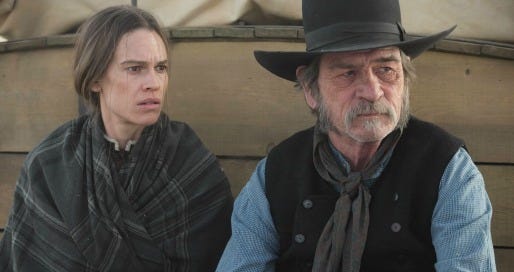The Homesman
“The Homesman” exists somewhere in that netherworld between the Western and the anti-Western. It celebrates the austerity and grit of the mid-1800s, and the people who settled west of the Mississippi River, but also casts an unsparing, gimlet eye on the brutality of those times — and those who made it so.
It’s the sort of movie full of horses and guns and stare-downs between desperate folks, but it’s not really about those things. There is little actual violence, and that which does transpire ill comports with the uses traditionally seen in this terrain of filmmaking.
Story-wise it kind of jags this way and that, like a drunken rider upon a lame horse, neither one too sure about the navigation. But it contains a brilliant performance by Hilary Swank, full of contradictory emotions and urges that nonetheless seem perfectly confined inside a character who feels urgent and alive.
And Tommy Lee Jones, who co-stars and also directed and co-wrote the film, isn’t half-bad himself. Not to mention an impressive supporting cast that includes the likes of Meryl Streep, Hailee Steinfeld, John Lithgow, James Spader and Tim Blake Nelson.
Based upon a book by Glendon Swarthout, the story concerns a journey from Nebraska to Iowa roundabouts 1850 to return three wives who have gone crazy on the lonely plains to their families back East. Their husbands are reluctant to leave their crops or children to make the long, arduous journey, so Mary Bee Cuddy (Swank) steps forward.
To all outward appearances, Mary Bee is a marvel. An educated woman from New York, she runs a prosperous claim including prime farmland, stock and a tidy house. She is active in her church and community — as much as one can be when you measure the distance to neighbors in miles — and respected by all. She is, as one forthright fellow puts it, as good a man as any man in these parts.
But there is an itchy desperation to Mary Bee, driven by the fact that she is 31 years old (firmly into spinsterhood), a mite bossy and “plain as an old tin pail,” to use a variation on a common refrain. As the story opens she essentially throws herself at a callow clod with whom she has lately been social. “Why not marry?” she proposes, going on to outline the financial benefits of a pairing, and we sense this not the first time such a speech has been given.
Rejected, Mary Bee agrees to oversee three women who have been more successful in getting married, but not in what comes after. Played by Miranda Otto, Sonja Richter and Grace Gummer, each has experienced extreme tragedy that has driven them over the edge, including the death of children due to causes natural ... and otherwise.
The trio exists as ghostly, wordless figures of pity, though Jones and his co-screenwriters (Wesley A. Oliver and Kieran Fitzgerald) are careful to show glimpses of the cruel lives that made them so.
Her charges locked into a boxed wagon, Mary Bee begins her expedition but stumbles across a man sitting on a horse with a noose around his neck. He is George Briggs (Jones), a claim-jumper and man of constant wanderings. He agrees to assist Mary Bee in exchange for saving his life, and thus begins a volatile relationship built on distrust and resentment, but also a shared sense of solitariness.
Along the way they encounter the usual sorts of challenges — Indians, rapacious cowboys, bitter snows and stomachs shriveled from hunger. The real journey is in these two damaged people venturing toward a nexus where they can both abide. It would seem impossible; she has a despairing desire to be needed, while he holds his rootless freedom as his most cherished (and often only) possession.
I wish “The Homesman” had as coherent a sense of narrative as it does well-limned portraits of its main characters. Some of the encounters in the film, particularly in the second half, have little connective tissue with the themes and story that surround them. (One, a visit to an intended town that so far has only built a hotel, tries too transparently to borrow a page from “Unforgiven.”)
But Swank and Jones are well worth the price of admission on their own. In most Westerns the actions define the character, but here it’s the words, said and unsaid, that offer a peek inside distant souls.
4 Yaps




